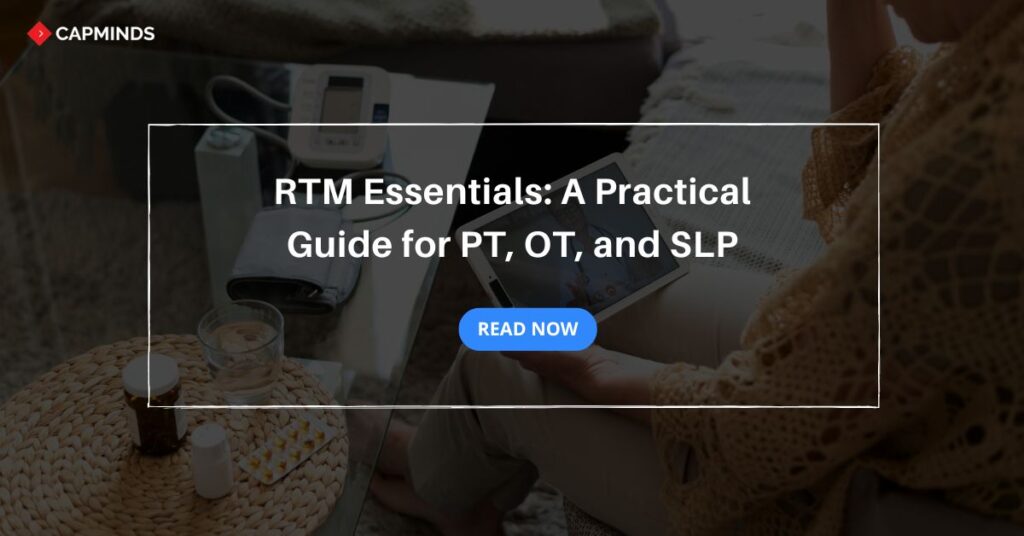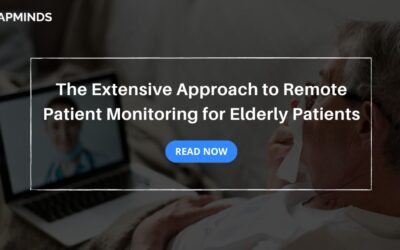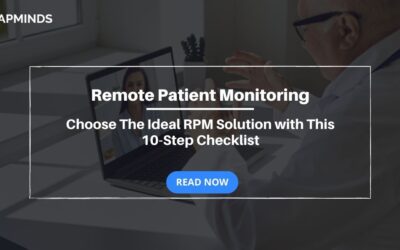RTM Essentials: A Practical Guide for PT, OT, and SLP
Remote Therapeutic Monitoring is the future of care delivery, more than 30 million U.S. adults are relying on the musculoskeletal and respiratory approaches. RTM enables providers to assess therapy efficiently from a distance allowing unique musculoskeletal and respiratory disease management.
With new CPT codes that started appearing in 2022, the RTM has worked well in the billing context opening the door for wider applications. It was reported that patients’ participation rates increase by 25% when remote monitoring is applied and improved clinical data quality. In this blog post, you’ll learn the differences between RPM, Medicare coverage insights, and the numerous benefits of RTM.
What is Remote Therapeutic Monitoring?
Remote Therapeutic Monitoring is the practice of routinely diagnosing a patient by monitoring through technological means outside the clinic. Patients manage health information, especially concerning the musculoskeletal and respiratory systems from their homes through connected health devices.
These connected medical devices and software enable patients to enter data on their own, which is an important aspect for rehabilitation therapists who must:
- Check up on patient pain tolerance levels
- Therapy endurance
- Other relevant information while undergoing the course of treatment.
This technology can provide very useful insights into the patient’s treatment progress, patient therapy adherence, and overall health trends.
According to the American Medical Association, remote monitoring services like RTM seek significant growth with a projected market value of 20% increase annually.
RTM vs. RPM: Key Differences
While both the RPM and RTM aim to monitor patients remotely, their areas of focus differ from one another. Here is the key difference between RTM and RPM:
- Remote Therapeutic Monitoring which includes Musculoskeletal and Respiratory systems and patient/therapist interactive therapy response.
- RPM means Remote Patient Monitoring, this is largely implemented as it relates to assessing the patients who have chronic diseases and majorly emphasizes monitoring the health data such as high blood pressure, high sugar level, high pulse rate, etc.
RTM is most relevant for physiotherapy, rehabilitation, or any other kind of advanced specialized approaches kind of care settings because according to this theory, performing RTM, care interventions are more inclined toward therapy.
RPM is often applied in chronic illnesses, for example, diabetes and hypertension.
Related: RPM in Healthcare and How it Ensures Quality Care to Patients
CPT Codes for Remote Therapeutic Monitoring
Billing and Coding for RTM completely differ from others. It has specific CPT codes that providers use to bill for services rendered and get reimbursements.
1. CPT Code 98975: Initial Set-up and Patient Education
This code covers setting up the monitoring system initially and instructing patients on how to utilize it. It pertains to patient onboarding into the program and the integration of RTM devices. Accurate data collection and patient adherence depend on appropriate training.
Fee Range: Based on Medicare reimbursement rates, providers can normally make between $18 and $25 for this procedure.
2. CPT Code 98977: Supply of Device for Monitoring Musculoskeletal System
The provision of the equipment required for RTM of the musculoskeletal system is covered under CPT 98977. This comprises devices that monitor data linked to therapy, such as respiration rates or movement measures.
Fee Range: Typically, $50 to $60 is reimbursed for this service per billing period.
3. CPT Code 98980: Monitoring/Treatment Management Services; first 20 minutes
In addition to providing therapeutic interventions, this code is employed for data collection monitoring, and interpretation. The first twenty minutes of therapy management are covered each calendar month.
Fee Range: For this service, Medicare normally pays providers between $50 and $55.
4. CPT Code 98981: Monitoring/Treatment Management Services; each additional 20 minutes
CPT 98981 is activated for each extra 20 minutes of management and monitoring. It enables healthcare professionals to keep providing the comprehensive treatment that the patient’s condition demands.
Fee Range: The additional reimbursements for each session range from $40 to $50.
Medicare Coverage for Remote Therapeutic Monitoring
Medicare expanded its benefits to include RTM. This coverage does seem to improve patient outcomes. Conditions under which RTM is reimbursed are nearly indistinguishable from RPM conditions.
- Eligibility: In RTM, patients are included who have constant conditions like musculoskeletal or respiratory disorders.
- Reimbursement Model Payment is based on the use of CPT codes such as 98975, 98977, 98980, and 98981.
Medicare support has encouraged increasing numbers of providers to embrace RTM, especially more in the specialty of physiotherapy and rehabilitation since those are more value for money.
Related: The Extensive Approach to Remote Patient Monitoring for Elderly Patients
Benefits of Remote Therapeutic Monitoring
1. Improved Data-Driven Decision Making
- RTM enables providers to gather real-time insights into a patient’s therapeutic response.
- This helps clinicians make better decisions and be more precise.
- With access to continuous data streams, providers can adjust treatment plans quickly which ultimately leads to better outcomes in patient health.
2. Enhanced Patient Access to Care
- RTM eliminates barriers to accessing quality care, particularly for those in rural or underserved areas.
- Patients can receive consistent care without frequent in-person visits.
- This way reduces the time and travel costs for patients.
3. Increased Patient Engagement and Better Outcomes
- When patients actively participate in their therapy through RTM devices, the adherence rates increase.
- Engaged patients are more likely to follow treatment protocols.
- This ultimately results in faster recoveries and improved overall health.
4. Fostering Stronger Patient-Provider Communication
- RTM encourages ongoing communication between patients and providers.
- Instant feedback mechanisms ensure that patients feel supported throughout their therapeutic journey.
- Promotes trust and satisfaction.
5. Higher Revenue Potential
- For healthcare providers, RTM is one of the best opportunities to get the extra revenue.
- By employing CPT codes and Medicare reimbursement, providers will be able to increase service delivery while enhancing the quality of the services delivered.
- Research shows that the organizations that have adopted RTM have had their revenues increase by as much as 15%.
Related: The Benefits of Integrating EHR and Remote Patient Monitoring
Remote Therapeutic Monitoring is revolutionizing the way healthcare providers manage their patients. For example, in PT or rehab, the providers can use RTM to deliver very specific and personalized care that would lead to better outcomes and higher revenues for the practice.
Undoubtedly, Medicare’s addition of RTM and its CPT codes are one of the reasons for practicing a liberal and sensitive healthcare system.
Whether a healthcare provider is looking for ideas on how to enhance the experiences of the patients you serve or a patient who wishes to have the most accessible treatments, RTM has a solution appropriate for advanced healthcare.
CapMinds Remote Therapeutic Monitoring Solution(RTM)
Are you prepared to improve clients’ outcomes with an integrated remote therapeutic monitoring system?
CapMinds RTM is an innovative m-health solution that supports healthcare professionals to monitor patient outcomes and adjust their treatment plans from remote locations, hence increasing engagement and efficacy of the treatment programs.
Our RTM solution benefits patients and healthcare practices in several ways:
Benefits for Patients:
- Personalized therapeutic support tailored to your needs
- Convenient communication with healthcare providers
- Improved adherence to treatment plans
- Reduced need for in-person visits
- Secure, HIPAA-compliant data sharing
Benefits for Healthcare Practices:
- Effective tracking of therapeutic progress
- Enhance practice efficiency and patient satisfaction
- Reduce hospital re-admissions with proactive care
- Detailed insights to refine treatment strategies
- Intuitive platform with customizable reporting tools
With CapMinds RTM, healthcare professionals can monitor therapy compliance, adjust treatments promptly, and provide timely interventions. Patients benefit from personalized care and convenience, fostering better health outcomes and confidence in their recovery journey.
Contact CapMinds today to learn how our RTM solution can revolutionize therapeutic care for both patients and providers, making expert support accessible anytime, anywhere.




